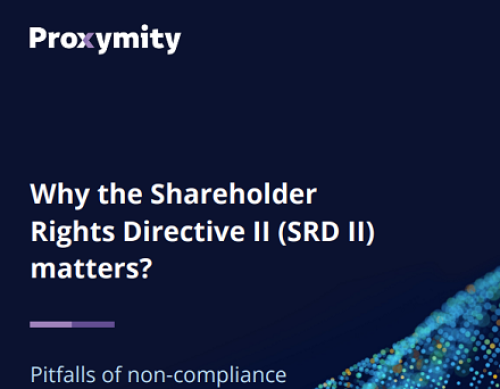Sponsored content
Since its implementation in January 2018, Mifid II has had a ripple effect on the financial system – not just in Europe, but also in the U.S. and more gradually in Asia. The aspect of Mifid II that has been most discussed from day one – and that has the most far-reaching implications – is how buy-side firms pay for the research they use to make investment decisions.
In the EU, Mifid II forced the unbundling of trading and research, with asset managers now having to budget separately for such research. The evolving trend has been for this to slowly make its way to the U.S., while becoming cemented into the EU financial system.
‘While Mifid II rules are not binding for U.S. firms that don’t do business in Europe, they are increasingly seen as best-in-class standards for all firms to adhere to,’ observes Addison Holmes, senior analyst at Nasdaq IR Intelligence in Chicago. ‘This means the average buy-side firm leverages fewer sell-side parties – reducing broker relationships for research, trading and corporate access.’
Indeed, the developing and changing paradigm has been revealed in IR Magazine, albeit with a nuanced take in the US.
In turn, there is no doubt that investment banks are reducing research output, and sales staff with top talent are moving from research into asset management and private equity. For the buy side, there have been cuts to external research – in some cases, dramatic cuts.
‘The exodus of sell-side analysts has occurred in conjunction with deteriorating research quality and quantity and the buy side sourcing less research from the sell side,’ comments Holmes.
Therefore, direct investor engagement is an emerging and important trend and is likely to become more significant. Here, IR teams have an important role to play in taking ownership of investor engagement.
‘From our conversations with companies, the approach of taking ownership is in direct reaction to a constant feeling of meeting the same investors over and over again at sell-side events or experiencing underwhelming roadshows,’ notes Holmes. ‘We find the companies that are strategic about their sell-side broker use are likely those that will weather any potential further impacts the evolving regulatory environment might bring.’
So Mifid II is proving to be a factor – and a major one – in forcing IR professionals to think about direct engagement. Does this represent a major shift? ‘I think this is a trend we are going to see more of, with large caps and small caps doing more outreach,’ comments Holmes. ‘The sell side is still a great vehicle for companies to distribute their story but, as the buy side limits its sell-side trading counterparties and brings research in-house, it is important for companies to be strategic on which sell-side brokers they leverage for investor engagement.’
She offers this advice on the new investor engagement dynamic: ‘When planning investor meetings through the sell side, it is vital to choose a partner that has strong relationships in cities with a high concentration of top opportunity investor targets.’
This seems like something IROs should really be focused on, but are they already doing it? ‘It varies by corporate,’ notes Holmes. ‘Sometimes we see clients go on the road with who they like the most, not who has the best relationships. However, I would say there is an awareness about choosing the right partner strategically.’ When planning, however, she stresses the importance of a partner with the greatest number of relationships.
What other ways are there to enhance investor engagement? ‘Companies still need to actively market their stories to investors,’ Holmes points out.
She says she has seen a real and practical benefit on an issue that has repeatedly been stressed to be vitally important to help the IRO: a trend toward boosting IR teams to facilitate the extra workload and focus, as well as the creation of IRO roles where they previously did not exist. This could prove a game changer within IR.
‘There are positive and negative impacts from Mifid II,’ Holmes concludes. ‘As a result of the legislation, we have seen a deterioration in research quality and the buy side working less with the sell side, instead bringing those responsibilities in-house. Embracing Mifid II is seen as embracing the best standards. We have seen our U.S. clients start to take ownership of investor engagement and reach out directly to buy side firms for meetings.’










